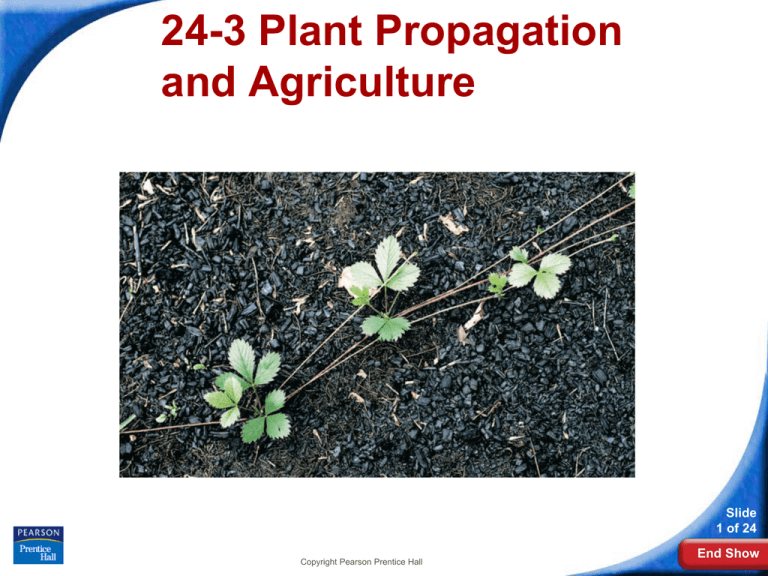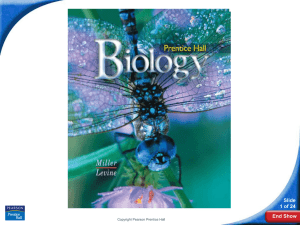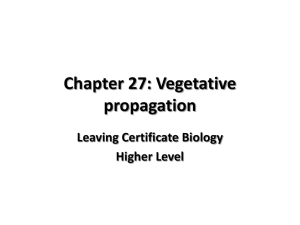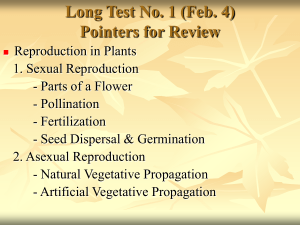24-3 Plant Propagation and Agriculture Slide 1 of 24
advertisement

24-3 Plant Propagation and Agriculture Slide 1 of 24 Copyright Pearson Prentice Hall End Show 24-3 Plant Propagation and Agriculture Vegetative Reproduction Vegetative Reproduction Vegetative reproduction is a method of asexual reproduction used by flowering plants. Vegetative reproduction enables a single plant to produce many offspring genetically identical to itself by mitosis alone. This process takes place naturally in many plants, and is also used as a technique by horticulturists who want to produce many copies of an individual plant. Slide 2 of 24 Copyright Pearson Prentice Hall End Show 24-3 Plant Propagation and Agriculture Vegetative Reproduction Vegetative reproduction includes the production of new plants from horizontal stems, plantlets, and underground roots. Because it does not involve pollination or seed formation, it enables plants to reproduce quickly. Some angiosperms produce tiny plants, or plantlets, at the tips of elongated stems. If the plant is knocked over or if plantlets fall off, they can take root and grow into new plants. Slide 3 of 24 Copyright Pearson Prentice Hall End Show 24-3 Plant Propagation and Agriculture Vegetative Reproduction Other plants grow horizontal stems. These long trailing stems, called stolons, produce roots when they touch the ground. Once the roots are well established, each stolon may be broken, forming a new independent plant. Bamboo plants grow long underground stems that can send up new shoots in several places. Stolons of strawberry plant. Bamboo forests are often descendents of a single bamboo plant that has reproduced asexually. Copyright Pearson Prentice Hall Slide 4 of 24 End Show 24-3 Plant Propagation and Agriculture Plant Propagation Plant Propagation In plant propagation, horticulturists use cuttings, grafting, or budding to make many identical copies of a plant or to produce offspring from seedless plants. Slide 5 of 24 Copyright Pearson Prentice Hall End Show 24-3 Plant Propagation and Agriculture Plant Propagation Cuttings One of the simplest ways to reproduce plants vegetatively is by cuttings. A grower “cuts” a plant stem that includes buds containing meristematic tissue. That stem is then partially buried in soil or in a special rooting mixture. Some plants are treated with rooting powders to help them grow. Slide 6 of 24 Copyright Pearson Prentice Hall End Show 24-3 Plant Propagation and Agriculture Plant Propagation Grafting and Budding Grafting and budding are used to reproduce seedless plants and varieties of woody plants that do not produce strong root systems. A piece of stem or a lateral bud is cut from the parent plant and attached to another plant. The cut piece is called the scion, and the plant to which it is attached is called the stock. Slide 7 of 24 Copyright Pearson Prentice Hall End Show 24-3 Plant Propagation and Agriculture Plant Propagation When stems are used as scions, the process is called grafting. When buds are used as scions, the process is called budding. Grafting usually works best when plants are dormant because the wounds created can heal before new growth starts. In all cases, grafts are successful only if the vascular cambiums of the scion and stock are firmly connected. Slide 8 of 24 Copyright Pearson Prentice Hall End Show






